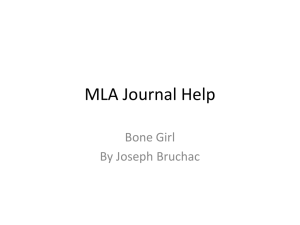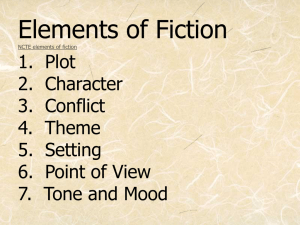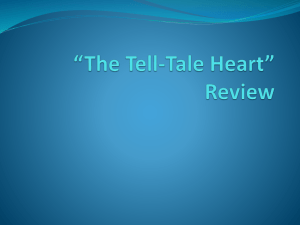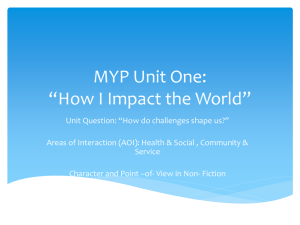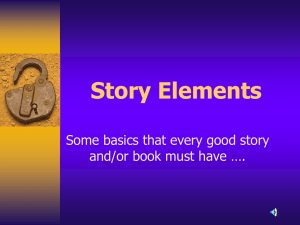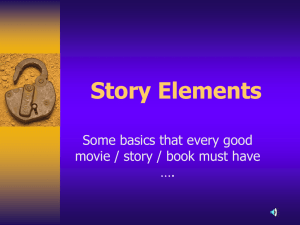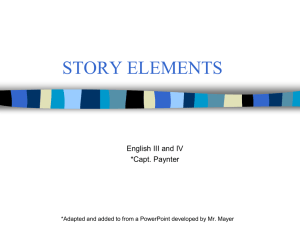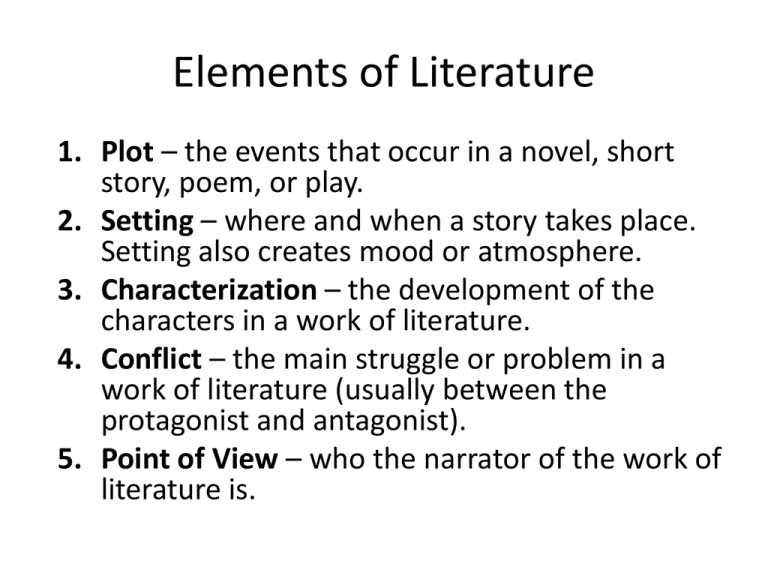
Elements of Literature
1. Plot – the events that occur in a novel, short
story, poem, or play.
2. Setting – where and when a story takes place.
Setting also creates mood or atmosphere.
3. Characterization – the development of the
characters in a work of literature.
4. Conflict – the main struggle or problem in a
work of literature (usually between the
protagonist and antagonist).
5. Point of View – who the narrator of the work of
literature is.
SETTING
CHARACTERIZATION
PLOT
CONFLICT
POINT OF
VIEW
“The Use of Force”
• Possible themes:
1. The justification of an authority figure using
force
2. The abuse of power/authority
“The Use of Force”
• Characterization:
1. In a few sentences, depict how Williams
characterizes the doctor. In other words, what
image does Williams portray of this man? Use
at least TWO or THREE examples from the text.
Hint: Do so in chronological order. Are there
any hints as to what kind of person the doctor
is in the first four to five paragraphs?
• Arrogant?
• Condescending?
HW
• On loose-leaf or a typed response, write a
paragraph of 7-8 sentences that describes the
doctor in the short story, “The Use of Force.”
Use at least THREE examples that support
your claim.
Other Themes to Explore…
• Ethics…
• Is it right to hurt an individual to protect her
and society?
• More importantly, is it right to enjoy it?
• If you were the doctor, how would you have
handled the situation?
“The Ones Who Walk Away from
Omelas” by Ursula Le Guin
• Before reading:
1. Omelas is a made-up city that LeGuin describes
as a utopia.
2. Utopia – the ideal or perfect society.
• As we read, with a pen, underline or highlight
the qualities of Omelas that make it a utopia.
• Homework: Find a COMMON theme in
William’s short story, “The Use of Force” and
LeGuin’s short story, “The Ones Who Walk
Away From Omelas.” Write your response in
your binder.
Paragraph Writing Guidelines So Far…
1. Topic sentence (author, title, and address
the topic)
2. Development (Give necessary background
information so the writing flows)
3. Examples (Use at least one to two quotes)
4. Transition words and phrases
How to Use Quotes from the Text…
1. You can simply state what the author writes
or what a character says.
• For example, the doctor narrates, “I could
see they were all very nervous, eyeing me
up and down distrustfully” (1).
• Williams writes, “Both the mother and
father turned themselves inside out in
embarrassment and apology” (1).
How to Use Quotes from the Text…
• You can take an important part of a quote and
“fit” it in into your OWN sentence.
1. It is clear that the doctor is non-caring because
he sees that the family “were all very nervous”
and he does nothing to make them feel calm
(1).
2. Although the doctor’s claim that “the damned
little brat must be protected against her own
idiocy” might be true, he could have handled
the situation better (2).
Literary Elements…
• Goal: To understand the FOUR types of point
of view in literature and how they affect your
approach to reading.
1. First-person point of view (The pronoun “I”
is used. The protagonist is often referred to
as the narrator.)
• What are the advantages of an author using
the first-person point of view?
• What are the disadvantages?
Do Now
• Write a brief plot summary or synopsis (5-8
sentences) of your favorite television show,
episode, or movie. Write this summary as if
the person you are telling this to has never
seen this particular show, episode, or movie.
Developing Your Paragraph Writing…
• TOPIC
• EXAMPLE
• ANALYSIS
TTTTTTTTTTTTTTTTTTTTTTTTTTTTTTTTTTTTT
TTTTTTTTTTTTTTTTTTTTTTTTTTTTTTTTTTTEEEE
EEEEEEEEEEEEEEEEEEEEEEEEEEEEEEEEEEEEEEEE
EEAAAAAAAAAAAAAAAAAAAAAAAAAAAAAAAA
AAAAAAAAEEEEEEEEEEEEEEEEEEEEEEEEEEEEEEE
EEEEEEEEEEEAAAAAAAAAAAAAAAAAAAAAAAA
AAAAAAAAAAAAAAAAEEEEEEEEEEEEEEEEEEEEE
EEEEEEEEEEEEEEEEEEEEAAAAAAAAAAAAAAAAA
AAAAAAAAAAAAAA
Guidelines So Far…
1. Topic Sentence (Author, title, addresses the topic)
2. Development (as you provide examples and analyses,
you provide PLOT summary)
3. Examples (Use quotes and try to “fit” them in into
your own sentence. Also, think of the order of your
examples: Order of importance – usually
CHRONOLIGICAL)
4. Analysis (Examine and provide your interpretation of
the example)
5. Transition Words and Phrases
6. Use the LITERARY PRESENT TENSE.
The narrator in Hawkins’ short story, “Wedding Night,” can best be
characterized as a sexual predator. He is a man who has been working at a “bus
station magazine since nineteen fifty three, waiting for the right girl to come along
(1). Though his words “right girl” and the title of the short story itself may imply
that he is a decent man looking for a wife, his true identity is revealed as he
discloses details about his life. First of all, when he shares his story of being held up
by a “stocky white man in a brown jacket,” he admits to never being frightened
because he considers the robber to be just like him. This important detail reveals
two things about the narrator. He obviously implies that just like him, the robber is
a criminal. Further, the fact that the narrator can recall every detail about the holdup also shows that like many sexual predators or criminals, he is extremely
observant of his surroundings. Secondly, the narrator finally thinks that “the right
girl might come along” when he meets a girl in the 1960’s who is a hippie. Hippies
were known to be wanderers, traveling from city to city. The fact that the narrator
thinks this girl is the “right girl” reinforces the idea that he is a sexual predator.
Since hippies did not have a fixed home, he knows that she could be a perfect
target for a sex crime. Finally, the narrator invites this girl to his home and offers
her to stay there as long as she likes. As she sleeps, the narrator does indeed touch
her “inside her clothes” and confesses that he “woke up on fire, and the room was
turning” (1). Though the sexual act he commits is not clearly defined, there is no
doubt that the narrator of “Wedding Night” is controlled by his impulse to commit
some sort of sexual crime.
“Wedding Night”
Tom Hawkins
• In a well-written, well-developed paragraph, provide an indepth character analysis of the narrator in Hawkins’ short
story, “Wedding Night.”
• Guidelines:
1. Minimum: 10 sentences
2. Use at least TWO examples (think of the order of your
examples)
3. Analyze each example
4. Use at least TWO quotes from the text, and try to make
the quotes you use “fit” into your own sentence.
5. Use the present tense as learned in class today.


